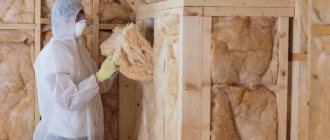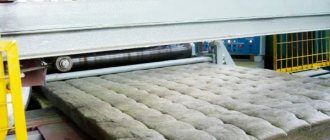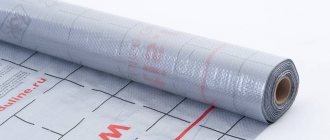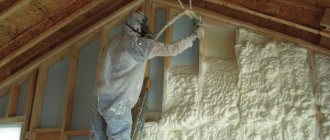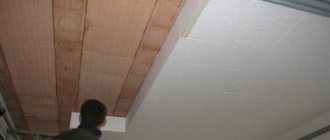What harm from glass wool is known to scientists?
Many expert assessments suggest that glass wool can cause problems in the body.
This is based on studies that have identified toxic substances in insulation - phenolic resins. They hold together the mineral particles of glass wool and perform a water-repellent function. Resins are capable of releasing phenol and formaldehyde, which are among the most dangerous substances. Phenol vapor is a strong poison that can affect entire organ systems. Diseases of the mucous membrane, central nervous system and respiratory tract can develop even when inhaling small doses of phenol. This negative factor is especially evident in rooms where there is high temperature. The effect of phenol and formaldehyde is enhanced.
Glass wool: harmfulness and effect on humans
The disadvantages of glass wool include its increased fragility. The fiber fragments have a thin and sharp structure. This allows them to penetrate clothing, skin and eyes. They are difficult to remove. Long-term irritation of the lungs causes severe discomfort. Glass wool insulation will not harm you if you wear special clothing during work, protect your skin as much as possible and use a respirator.
First aid for glass wool skin damage:
If glass wool gets on open areas of the body, you should not scratch it, so as not to drive harmful particles deeper into the skin. You should shake the material from your hair carefully so that particles do not get into your eyes. You should take a cold shower without using washcloths or detergents. The eyes are washed. After this you should go to an ophthalmologist. Clothes that have glass wool residue on them are thrown away.
What is more harmful: glass wool or basalt wool?
Basalt also contains microparticles that are held together by harmful phenolic resins. Therefore, basalt wool is much less harmful than glass wool. When working with any insulation, technology and safety precautions must be observed to eliminate their negative impact.
«>
How to work with glass wool: tips, mistakes + safety precautions
Glass wool is a very effective thermal insulation material (a type of mineral wool), the production of which uses waste from the glass industry. Almost every boy knows that if you touch this material with an open part of the body, itching and rash are inevitable, as if from nettles.
Glass wool must be handled very carefully as it can cause an allergic reaction. When working with it, there is a whole set of safety rules that make it possible to eliminate undesirable consequences.
Tips and safety precautions
Glass wool is supplied in rolls. In some cases, its layers need to be cut (in accordance with the parameters of the surface that is being insulated). A sharp knife is used for this. The size of the cut mats should exceed the previously measured values by several centimeters. This will create the necessary density of the material and will not affect the thermal protection performance at all.
When working with glass wool, you must wear a dust blower, gloves and safety glasses. In addition, it is advisable to have clothing that can cover all parts of the body (tight overalls). As soon as the work with glass wool has been completed, it is important to carry out a thorough wet cleaning of the room. The result of all manipulations should be a shower.
Upon direct contact with glass wool, the first signs of irritation appear on the skin, itching, redness and other unpleasant sensations are observed. The safety measures indicated above can protect the human body from the negative effects of glass wool, however, it is not always possible to avoid direct contact.
First aid
Upon completion of all work with glass wool, work clothes must be washed thoroughly and repeatedly. But this does not guarantee complete removal of the fibers causing irritation. You can buy glass wool on the website https://ursa-russia.ru/, or purchase it in a specialized store... This is completely unimportant, because its properties, regardless of the manufacturer, remain identical. When working with this material, there is a high probability of direct contact. In this case it is necessary:
- don't itch. If small fibers get on the skin, additional mechanical damage to the skin will only worsen the situation.
- act carefully. If glass wool dust falls on your hair, you need to carefully shake it off, closing your eyes, and wash your hair thoroughly at home.
- Always take a shower (water temperature at room temperature), which helps reduce skin irritation and remove all small fibers of glass wool. It is important not to use a bathtub, but to give preference to a shower with relatively high pressure. You need to wash yourself without using any hygiene products or washcloths. The former expand the pores, facilitating the penetration of unwanted elements into the inner layers of the skin, while the latter will clearly retain those same irritants - microparticles.
If glass wool dust gets into your eyes, it is important to immediately rinse them with cold water under strong pressure. Obviously, the mucous membrane will be irritated. If symptoms have not gone away after 2 hours (burning and redness), you should immediately visit an ophthalmologist.
Is glass wool harmful to health?
Health hazards of glass wool when inhaled:
The harm of glass wool lies in its mineral particles. During operational processes, microparticles from the insulating material are released into the air. Glass wool is more harmful to health indoors than outdoors. When the room is rarely ventilated, the particles end up in a person’s inhalation tract and penetrate into the lungs.
The health hazards of glass wool manifest themselves not only in the form of allergic reactions. Over time, with constant contact with the material and non-compliance with safety rules, various diseases affecting the respiratory system can develop. In some cases, even oncological complications were observed. Such negative consequences are typical for those who have constant contact with glass wool. Therefore, glass wool is not recommended for insulation in residential premises.
Harm to health upon contact:
The danger of glass wool manifests itself not only when inhaling its vapors, but also through direct contact with the skin. The most common cases of negative effects of insulation were observed during installation. Solid particles can damage the skin layer and penetrate deep into the skin. This causes itching and irritation. If glass wool gets on an open area of the body, it is strictly forbidden to scratch it. Microparticles can only be removed using running water. It is better to do this in the shower and not use soap or gels. After rinsing, it is not recommended to dry with a towel.
Why is glass wool harmful when it comes into contact with mucous membranes and eyes?
Microscopic particles containing glass may damage the eyes. To avoid serious complications, you should immediately consult a doctor and undergo an examination.
Harm of glass wool to the skin
During direct contact of glass wool with human skin, when laying it they work without gloves or special clothing, sharp fragments of microparticles penetrate inside and cause skin irritation, at the site of contact it becomes red and itching appears.
The particles can damage the skin and penetrate deep into the dermis, causing allergies. You should refrain from scratching the affected areas. Glass wool should be removed under clean running water.
This is important: all repair work with glass wool must be carried out while wearing protective clothing and rubber gloves or tarpaulin mittens.
Negative Features
You now know what glass wool is made from, but for a complete picture you also need to take an interest in the negative features of this material. Among others, it is worth highlighting:
- susceptibility to shrinkage;
- fragility of fibers;
- insufficiently good thermal insulation properties;
- low level of density;
- the need for additional use of waterproofing film.
The material may shrink during operation, which must be taken into account during construction.
It is also important to pay attention to the fragility of the fibers, as well as the fact that the material is afraid of water. For protection you have to use special means
Glass wool, the characteristics of which were presented above, also has a certain thermal conductivity. This coefficient must be less than one
It is important to remember that the material is of higher quality if this parameter is lower. Many people also know that glass wool is unsafe for health.
However, on the modern market there are products based on this material that no longer contain harmful substances. But working with this thermal insulation is not very convenient, because it crumbles, so you should additionally use personal protective equipment, namely:
- gloves;
- glasses;
- costume.
Advantages and disadvantages
If you decide to go with glass wool, you first need to study the pros and cons of this material. So, the advantages of glass wool include:
- frost resistance and fire resistance (after all, many are interested in whether glass wool burns or not);
- ease of use of products when working in hard-to-reach places;
- low cost, which is often a determining factor;
- resistance to high and low temperatures;
- the material is not susceptible to chemical reagents;
- Rodents do not like glass wool, so the material does not need to be equipped with additional protection against small pests.
True, one should also take into account the disadvantages of glass wool, which will “open up” when using the material. These include:
- the material shrinks, which is important to consider during construction;
- increased level of fiber fragility;
- insufficiently high thermal insulation properties;
- low density level;
- fear of water, which leads to the need to use a waterproofing film to protect the material.
When paying attention to the insulation, you need to take into account the thermal conductivity of glass wool. So, the thermal conductivity coefficient should be below 1, and the lower this indicator, the better. You can often hear that this material is unsafe for health. Modern manufacturers produce products that do not contain substances harmful to health. However, due to the fact that this material crumbles, it is advisable to work with it in a protective suit, goggles and gloves.
What is the potential danger of each variety?
Mineral wool refers to fiber made from materials such as glass, stone, and slag. Depending on the source raw material, it is called glass wool, slag wool or stone (basalt) wool, respectively.
80% of glass wool production is represented by cullet; limestone and soda, ethiboron and sand are also present. The main disadvantage of the resulting material is its fragility and fragility. During work, the smallest particles of glass wool can easily penetrate not only under clothing, but also into the respiratory tract. Therefore, according to safety precautions, you should carry out work in special clothing, covering your face with a respirator and safety glasses. Clothing can no longer be cleaned or washed.
The basis of slag wool is blast furnace slag, which tends to form an aggressive environment for metals due to residual acidity. Slag wool fibers are no less fragile than glass wool.
Stone wool is made from rocks of the gabbro-basalt group. Its fibers can withstand temperatures up to 1000 degrees, although the binder is only 250. They are not at all sharp, as in the previous two cases, which is why stone wool is most often used for insulating walls and roofs in residential construction.
But in addition to the fragility of the fibers, a potential danger to human health, according to organizations fighting for environmentally friendly homes, lies in the carcinogenic properties of mineral wool fibers. In the production of mineral wool, a binder is used - formaldehyde resin, which is capable of releasing formaldehyde into the surrounding space.
What mistakes can be made when laying insulation?
When laying material, many people make mistakes, causing irreparable harm to their health:
- Before working with cotton wool, thoroughly shake the insulation to get rid of volatile particles.
- The product has a high degree of moisture absorption. When decorating the outside of a room with this material, it is necessary to first use various substances, including waterproofing and vapor barrier, which leads to a decrease in thermal insulation properties.
- If the wet special material is not removed, this will lead to its fragility and shrinkage. The room is no longer protected from drafts.
- You should wear a respirator when working with cotton wool to avoid negative health consequences. Otherwise, a person will develop allergic reactions, asthma and other complex diseases.
If you do not have a respirator, you can use a cotton-gauze bandage folded in several layers.
- After the installation process, the room should be thoroughly ventilated.
- You need to wear a special suit to work with the material. It cannot be washed after installation. The best solution is to shake the product.
- To work, it is necessary to install the sheathing, applying lubricating polymer waterproofing to it.
- Do not ignore the contact of particles with the skin. If you encounter such a situation, wash them off with plenty of water.
- The structure is easy to install. In this case, safety regulations must be observed.
- If the substance has become unusable, it must be dismantled immediately. Over time, the material can release dangerous volatile particles.
Usually installing insulation is not difficult. To avoid problems, contact the services of professional craftsmen.
Production and technical characteristics of glass wool
The same components are used for production as in glass production: limestone, borax, sifted sand, dolomite, soda. Most manufacturers replace raw materials with glass cullet (up to 80%), which reduces the final cost and does not affect the quality of the product.
The production technology consists of several stages:
- The components (broken glass products, fillers) are immersed in a hopper and fused at a temperature of 1400°C.
- The molten mass is inflated under the influence of steam.
- Polymers are added to form threads.
- The fibers are directed to leveling rolls, which form a kind of “carpet” of fiberglass.
- Polymerization at 250°C. The remaining moisture evaporates, the material cools down and becomes yellowish.
- After cooling under natural conditions, the fiberglass is sent for pressing and cutting to size.
Production stages
The material is produced in slabs, mats, and rolls. Each manufacturer determines the dimensions of the slabs independently. The main parameters of insulation produced in rolls are presented in the table.
Roll sizes
The properties and characteristics are as follows:
- Thermal conductivity. Due to the fibrous structure, air is retained in the volume of the material, which ensures low thermal conductivity (0.039-0.047 W/m K.
- Sound absorption (35 to 40 dB). The fibers of the material do not contribute to the spread of vibrations and noise.
- Vapor permeability (0.6 mg/mh·Pa). According to this parameter, insulation has an advantage over other materials.
- Fire resistance. Before purchasing, many people doubt whether modern glass wool will burn? It can withstand temperatures up to 500°C, and under the influence of fire it begins to sinter smokelessly without the formation of hazardous substances.
- Moisture resistance. When partially immersed in liquid, the moisture absorption parameter is 15%.
- Biological inertia. Does not contribute to the development of fungal colonies, the appearance of rot, and is not interesting for rodents.
- Deformation stability. The insulation can be compressed 6 times without losing its properties, and after removing the load it straightens to its original volume.
- Density. Depending on the manufacturer, the parameter ranges from 11 to 25 kg/m3.
Glass wool has good characteristics
How to get rid of glass wool
stood sharp.
Since there wasn’t much to lose, I decided to get rid of the glass wool by washing my hands with Remoskin cleansing paste
And lo and behold, after just one use, the unpleasant sensation from the presence of glass wool particles on the hands disappeared. So, it turns out, the solution to the problem was always at hand, in my personal locker.
Now you know how to get rid of glass wool without any problems or harm to the skin. I hope my advice helped you.
Main characteristics
Various types of insulation materials are used in the construction industry. They have their own characteristics, characteristics and installation technology. Among them, new generation building insulation materials are gaining the most popularity. These include expanded polystyrene, mineral wool and penoplex. The well-known glass wool does not give up its position and is successfully used in the construction of industrial premises and residential buildings.
Glass wool is used in various types of house construction, does not require special skills for installation and has excellent thermal insulation and sound insulation qualities. It is a universal insulation material and has high strength, elasticity and resistance to vibration. Glass wool is necessary for external and internal work, when installing pitched roofs and insulating horizontal surfaces. It can be used to seal gaps and cracks in walls. Glass wool is available in different forms - rolls or slabs. Many experts successfully use the material in practice, but do not even take into account the harmful properties of glass wool.
Characteristics of glass wool
If you are faced with the question of what glass wool is, then first you need to familiarize yourself with its characteristics. Glass wool is made from melted glass melt, while the temperature is maintained above +1400 °C.
It is based on a mixture of sand and glass, which is drawn into fiber. The resulting product is assembled into packs, using a bitumen-based binding material.
The raw material is heated to +200 °C and then pressed. The materials are then cut or rolled into individual rolls and are then ready for delivery to the market. If you also wondered what glass wool is, then you should understand that it differs from basalt thermal insulation.
The first insulation option is lightweight due to the softness and length of the fibers, as well as their elasticity. Therefore, the material has excellent elasticity properties. This becomes especially noticeable when storing and transporting the material, since glass wool takes up a minimal amount of space.
After unpacking, it quickly returns to its original shape, which allows it to be used when working with different designs. When compared with stone wool, glass wool fiber has a thickness ranging from 3 to 15 microns. As for the length of the fibers, it is up to 4 times longer than that of stone wool.
The described insulation contains almost no non-fibrous inclusions, it has excellent vibration resistance. If you are faced with the question of what glass wool is, then you should ask about one of the important indicators - thermal conductivity. It is equal to from 0.030 to 0.052 W/m·K. But the temperature resistance reaches 450 °C.
Characteristics and composition of the material
https://www.youtube.com/watch?v=0Aqjkfc9rCs
Glass wool is produced from melted glass: at temperatures above +1400 °C, fiber is pulled from broken glass and sand. After this, the resulting products are collected into bundles using a special bitumen binding material, heated to +200 °C and pressed. The resulting materials are then cut or rolled into rolls and supplied to the market.
This glass wool differs in its properties from basalt insulation. Due to its length and softness, glass wool is light, elastic and has the best elasticity characteristics. This is especially noticeable when transporting and storing materials, since glass wool takes up quite a bit of space. By the way, after unpacking, the material quickly takes the desired shape, which makes it easy to use when working with various structures.
Insulation is used when:
- carrying out external work;
- working with horizontal surfaces;
- carrying out roofing work;
- insulation of walls and partitions;
- soundproofing.
In this case, for each of the selected spheres, different types of glass wool are selected according to the type of fiber. And each of the materials differs in the presence or absence of additional coating, thermal conductivity, arrangement of fibers, and the density of glass wool is also different. That is why, when choosing products, purchase a certain type of glass wool for the work. After all, only in this case can the quality and durability of the products be guaranteed.
Advantages of glass wool, its “advantages”
- good thermal insulation properties;
- has soundproofing properties, it protects well from external noise
- resistance to biological factors, it is not chewed by mice, rats and other pests;
- environmental safety and cleanliness, it is harmless to health;
- is a fireproof material, does not burn and does not support combustion;
- resistant to mold, mildew, corrosion;
- It weighs little and does not put a load on the load-bearing elements of the structure, provides ease of transportation and the possibility of quick installation “alone”;
- It has a low cost and is budget friendly.
Photo 2. Glass wool for thermal insulation is usually used in rolls; it is resistant to mold and rodent attacks
Main Differences Between Glass Wool and Stone Wool
So, the house is ready for insulation, but you still haven’t decided on the choice of thermal insulation. The main question sits in your head: should you buy newfangled stone wool, which is recognized by 70% of consumers around the world, or take old-fashioned glass wool? Let's determine the main factors that distinguish these thermal insulation materials from each other:
- Raw materials. Glass wool is blown from a synthetic material - a low-melting charge (glass production waste and broken glass). Stone wool is also produced from rocks based on basalt - a natural, environmentally friendly raw material, therefore it is successfully used for insulating residential premises.
- Non-flammability. Despite the fact that both materials are recognized as non-flammable, stone wool is more resistant to high temperatures. A basalt slab can withstand temperatures of about 750°C and not lose its geometric parameters, while glass wool sinteres into a candy when the temperature rises to 400 degrees.
- Susceptibility to shrinkage. The main disadvantage of glass wool is the ability to absorb moisture, which leads to the fragility of the fibers and their disintegration into small crystals at the slightest load, as a result of which the insulation loses its shape. Basalt wool is resistant to moisture (hygroscopicity index 0.5%), therefore it is not subject to shrinkage throughout its entire service life.
- Chemical resistance. Stone wool is not afraid of alkalis, acids and other aggressive environments, while glass wool reacts with them and is destroyed.
Important fact! According to the results of the examination of three-layer reinforced concrete panels, in which glass wool was used as a thermal insulation layer, when opened after 5-15 years, one rot was discovered.
installation of glass wool requires the use of special clothing and protective equipment
Ease of installation. If working with basalt wool does not require the use of a respirator and gloves, then installing glass wool requires full equipment, otherwise the glass wool fibers eat into the skin, and glass dust enters the respiratory tract, causing serious health problems.
The facts speak for themselves, but if you still have doubts, move on. Let's consider the most pressing consumer question. You probably guessed what we're talking about? Absolutely right. Let's talk about how to make the most of the contents of your wallet.
Features of working with glass wool
Before you start working with insulation, you should remember: if handled carelessly, glass wool can be harmful to health. To minimize risks and protect yourself you need to:
- Carefully straighten the rolls or sheets, clean them from crumbling particles.
- Apply the adhesive composition, press the insulation to the surface, hold for several minutes. When insulating ceilings or walls, it is necessary to install additional fasteners, use lathing, or perform waterproofing.
- The use of special clothing and personal protective equipment (goggles, respirator, gloves) is mandatory.
- Upon completion of work, wash your hands and face thoroughly. The harm of glass wool lies in the fact that its fibers are practically not washed out of fabrics, so it is not recommended to reuse contaminated workwear.
If fibers get into the respiratory system or on the skin, you should consult a doctor, since it is impossible to alleviate the situation at home. Is working with glass wool harmful to health? Of course yes.
When laying, it is mandatory to use PPE
Working with insulation is not difficult at all - it can be easily cut to the required size using industrial scissors or a hand saw with fine teeth. Fiberglass wool can be laid with a slight overlap (up to 3 cm), and then the excess is compacted into the frame.
Glass wool is dangerous because it consists of very small elements in the form of dust, which easily rise into the air, settling on the skin and getting into the lungs.
The fine fiberglass fibers are white or light yellow in color and are difficult to see when they are embedded in the skin. To successfully remove large fragments, good lighting and a magnifying glass are necessary. You can remove it with tweezers or a needle, prying up the base of a large sliver.
Working with fiberglass with your hands, without special gloves, guarantees skin irritation. If your hands are already completely covered in small fragments that cannot be picked up with tweezers, take a roll of wide adhesive tape (such as paper tape, clear tape, or duct tape). The main thing is that it does not tear into pieces when peeling off from the surface of the skin.
Do not bandage or cover the affected area with duct tape. This will only worsen the penetration of the fiber deep into the skin. Warm water will help steam the damaged surface, and some of the irritating elements will simply be washed away.
Press the tape firmly onto the affected area and hold it with your hand for several minutes. Make sure the tape makes good contact with the skin and glass shards.
Staple fiberglass: harmful to skin and eyes
If the process of laying fiberglass was carried out without special clothing and gloves, then sharp particles could get onto the surface of a person’s skin and penetrate inside. This may cause irritation and allergies. Most often, the first signs are itching, redness and pain at the points of penetration. You should not scratch the reddened areas, and first aid consists of rinsing the skin under cold running water.
Everyone knows that glass wool is highly brittle. For this reason, sharp, invisible debris can come into contact with a person's eyes. The work should be performed exclusively with special glasses to prevent further problems.
Among the main symptoms of exposure are the following:
- Sharp, cutting pain in the eyes;
- The appearance of a large stream of tears;
- Discomfort;
- Pain that gets worse.
Taking any independent action in this case is not recommended. If you have at least one of the above signs, you should immediately go to the hospital.
How to work with fiberglass
Experts offer some tips for working with fiberglass that will help protect your health.
For example:
- When working, use disposable special clothing with a hood;
- Wear safety glasses;
- Cover your hair with a hat or cap;
- Make sure that your hands do not come into contact with the material; use mittens or gloves;
- If the material is loose, work in a cotton-gauze bandage;
- If glass wool gets on an open area of skin, take a shower to wash off all the microparticles;
- Do not try to wash your work clothes; if there is a need for cleaning, shake off the dust vigorously.
But the most important thing, in the event of an injury, is to go to a medical facility, since it is almost impossible to alleviate the situation at home. The harmfulness of staple fiber is obvious. The danger can be anything from itching, bronchitis (if inhaled) and the big list ends with body allergies. How dangerous cotton wool is and what to do to get rid of the consequences can be found out in a special video. How to work in such conditions, how to cleanse the skin of small particles, whether it will be enough to simply wash yourself, and what to eat if poisoned, you can learn all this in video format.
Insulation materials
There are a large number of different insulation materials. They differ in both material and shape. You can use fiber or board materials. In places with severe space limitations, it is more convenient to use fiber, and slabs are more suitable for insulating walls.
Until recently, the most popular insulation was various types of mineral wool, including glass wool. Such materials have a number of advantages:
- cheapness;
- ease of use;
- good insulation properties;
- water resistance.
Lately, glass wool has been used less and less. The reason is the emergence of new, more convenient polymer-based materials. They have better insulating properties and are just as cheap. In addition, the question often arises: is glass wool dangerous for humans?
The damage to glass wool is caused by two groups of factors: mineral particles and the connecting substance.
Mineral particles
These are microparticles, of which cotton wool actually consists. During the operation of the material, microparticles are detached from the base and enter the air. If the room is rarely ventilated, and there is a lot of glass wool in it, then these particles naturally end up in a person’s lungs.
Systematic inhalation of microparticles is fraught with allergic reactions, the formation of chronic respiratory diseases and even the development of oncology.
To “achieve” this effect, you need to inhale cotton wool particles regularly. If a bathhouse where you do not live is insulated with cotton wool, then there will be no particular harm to health. But it is not recommended to actively use cotton wool in residential premises.
However, even in a bathhouse, glass wool can cause some harm, especially during the installation process. We are talking about direct contact with the skin. Solid particles of cotton wool damage the skin and can penetrate quite deeply. Therefore, after contact with glass wool, you should absolutely not itch. It is necessary to remove particles from the skin in the shower, under cold water, without using detergents. After a shower, by the way, you shouldn’t dry yourself with a towel.
If glass wool particles get into your eyes, it is recommended to seek immediate medical attention as they can cause serious damage.
It is worth noting that modern glass wool, labeled for use in residential premises, meets sanitary standards. But such material will be much more expensive, and it is not a fact that the manufacturer strictly followed the technology.
Connecting agent
We are talking about a substance that binds the fibers of mineral particles and gives it the property of water resistance. As a rule, these are phenolic resins, which can release hazardous substances - phenol and formaldehyde.
Phenol is extremely toxic and causes damage to various organs (mainly mucous membranes, respiratory organs and nervous system).
Regular inhalation of even minimal doses of phenol can lead to serious illnesses.
It is worth noting that this negative factor is most relevant specifically for baths. The reason is that phenol and formaldehyde are released as volatile compounds when exposed to high temperatures.
Simple precautions
The health hazards of glass wool are not fatal during short-term work with the material, but can be critical for the respiratory system during prolonged inhalation of glass dust. It is necessary to understand that the harm of glass wool to humans can lead to irreparable consequences and chronic diseases.
When installing insulation, use the simplest methods of protection against glass wool. Wear gloves or clothing that prevent fiberglass from coming into contact with your skin. Do not rub or scratch the skin if you see fibers on its surface. Do not touch your eyes or face when working with fiberglass; wear safety glasses or a mask or respirator to avoid getting tiny particles into your eyes and lungs.
Pants and long-sleeved shirts are the best and easiest option for protecting your skin. This will significantly reduce the chances of irritating elements coming into contact with your skin.
When working with glass wool, special clothing is also necessary to prevent splinters of cotton wool from penetrating deep into the skin when an already affected area of skin comes into contact with any surface. Rubbing the scratches will only cause the fiberglass fibers to sink deeper into the skin, where they will break into fragments. If you notice dust on your skin, do not scratch it, just wash it off with plenty of cool water.
After you finish working with fiberglass, wash your hands well and immediately remove your clothes to wash. Pre-clean your clothes with a damp brush if they have been exposed to dust for a long time.
If fiber gets into your eyes, rinse them with cool water for at least 15 minutes, then consult a doctor to have them examined with appropriate equipment. Do not rub your eyes under any circumstances!
Which insulation is better: glass wool or mineral wool?
If I had to choose between glass wool and mineral wool, I would still choose our building material - glass wool. One of the most important advantages that especially attracted me was that there were no mice or other living creatures in it.
More. With the same thickness, glass wool is 10...15% warmer than basalt wool and cheaper. Glass wool has longer fibers than basalt wool, so less glue is used in the manufacture of glass wool, which means less formaldehyde.
Mineral wool should be used only where it is possible to put a reliable layer against the penetration of formaldehyde into the living space. In general, it must be used wisely to insulate facades, because health (lack of it) is an even more expensive thing than building a house.
I made my choice, I hope that my review will be useful to you, and you will also make your right choice.
glass wool technical characteristics
What harm does your lungs get if you inhale glass wool: what to do
The harm from glass wool can be characterized by the fact that it contains mineral particles containing phenol resins. If glass wool was used in a confined space, then toxic phenol begins to be released into the air, and it is these fumes that a person begins to inhale with his lungs. All this highlights certain consequences.
Glass wool is used in various types of house construction, does not require special skills for installation and has excellent thermal insulation and sound insulation qualities
Namely:
- The appearance of an allergic reaction under the guise of a cough;
- Shortness of breath;
- Inflammatory processes of the respiratory system, which can become chronic.
It is an established fact that people who frequently work with glass wool are susceptible to lung cancer. Scientists have also proven that microparticles included in glass wool can cause dermatosis, bronchitis of both chronic and obstructive types, and it is also possible to develop a fungal infection of a bacterial type.
It is very important to remember that when working with glass wool, it is better to remove all soft objects from the room, such as toys, carpets, and upholstered furniture should be covered, since they become collectors of microparticles. At the end of the work, you need to carry out wet cleaning using a washing vacuum cleaner and it is advisable to install an air humidifier
Harm of glass wool to the lungs
Small particles of glass wool can get into a person's lungs. The harm from glass wool to health is characterized by the fact that the composition contains mineral particles and phenol resins, which are added to hold these particles together.
If glass wool is used in an enclosed area, particles and toxic phenol are released into the air, which are inhaled by the lungs of people present there.
Harmful microparticles are not removed from the lungs for a long time, and can cause:
- allergic reaction in the form of a dry cough;
- shortness of breath;
- respiratory diseases that become chronic.
It's a fact: people who deal with glass wool are at risk for lung cancer.
Pulmonologist D. Vinogradov, associate professor of the 1st Moscow State Medical University named after. Sechenov notes that microparticles can cause various dermatoses, chronic and obstructive bronchitis, against this background there is the possibility of developing bacterial and fungal infections.
You need to know: indoor plants help bind mineral dust. Carpets and all sorts of soft toys are dust collectors. When cleaning a room with glass wool insulation elements, it is recommended to use a washing vacuum cleaner or install an air humidifier in the room
Glass wool floor and roof insulation technology
Floor insulation with fiberglass mineral wool is carried out using rolled material with a density of 11 kg/m3. The insulation is laid on the vapor barrier between the joists in 2-3 layers. The top of the insulator is covered with another layer of vapor barrier film. There is no need to fix Iover.
Glass wool with a density of 15-18 kg/m3 is used to insulate roofs or frame partitions. Use mats or slabs for work. They are laid between the rafters or wooden sheathing is made along the rafters.
Photo 4. For floor insulation, glass wool in rolls is usually used, laid on a vapor barrier between the joists
The stages of work on insulating a pitched roof are as follows:
- installation of waterproofing or vapor barrier film between the rafters;
- the slabs are cut 0.5-1 cm larger than the distance between the rafters. Installation is carried out with minimal fixation of the slabs. They will hold due to the spacer effect. The thermal insulation layer on top is covered with a continuous vapor barrier. Installation of glass wool slabs on wooden sheathing is also carried out as a vapor barrier; the wool is laid in 2 overlapping layers, overlapping the seams of the slabs. The thermal insulation layer is sewn on top with a vapor barrier.
Technology of using glass wool in ventilated facades
To create a ventilated facade, glass wool with a density of 20-30 kg/m3 (insulation Isover 100 /E/K) is suitable. It is designed for three-layer masonry and external thermal insulation. To increase the thermal insulation properties, it is recommended to take rolls with fiberglass caching.
Stages of work:
- Preparing the wall surface, cleaning and leveling using special mastic.
- Installation of vapor barrier.
- Rigid glass wool slabs are mounted using umbrella plastic dowels.
- The top layer of fiberglass insulation is covered with a vapor barrier.
- The frame sheathing is made of wood or a metal guide profile.
- Finishing is done with siding, tiles or other materials.
Results
Mineral wool is a safe material, and its health hazards are greatly exaggerated. Of course, there are types that create a lot of dust during installation, but this can be solved by using a respirator. The dust is subsequently neutralized by a vapor barrier film. There are prickly materials that make your skin itch. But again, if safety precautions are followed during installation, this problem does not arise. And the fact that mineral wool contains phenol-formaldehyde does not mean that it somehow leaves the structure of the material. In addition, this component is present in all plastics, not to mention other materials.
Manufacturers such as Knauf and Ursa have a line of materials that use an acrylic-based substance as a binder. This insulation is definitely safe. If these arguments are not enough, then you can insulate with natural materials of natural origin, for example, sawdust, straw or expanded clay.
